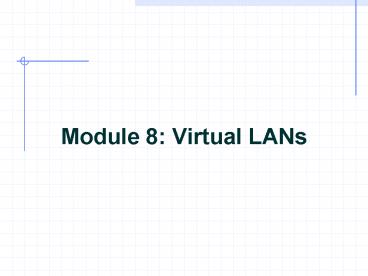Module 8: Virtual LANs - PowerPoint PPT Presentation
1 / 21
Title:
Module 8: Virtual LANs
Description:
... VLANs allow for membership based on the MAC address of the device connected to the switch port. ... based VLANs. MAC address based VLANs. Protocol based ... – PowerPoint PPT presentation
Number of Views:73
Avg rating:3.0/5.0
Title: Module 8: Virtual LANs
1
Module 8 Virtual LANs
2
VLAN introduction
- VLANs logically segment switched networks based
on the functions, project teams, or applications
of the organization regardless of the physical
location or connections to the network. - All workstations and servers used by a particular
workgroup share the same VLAN, regardless of the
physical connection or location.
3
VLAN introduction
- A workstation in a VLAN group is restricted to
communicating with file servers in the same VLAN
group.
4
VLAN introduction
- VLANs function by logically segmenting the
network into different broadcast domains so that
packets are only switched between ports that are
designated for the same VLAN.
- Routers in VLAN topologies provide broadcast
filtering, security, and traffic flow management.
5
VLAN introduction
- VLANs address scalability, security, and network
management. - Switches may not bridge any traffic between
VLANs, as this would violate the integrity of the
VLAN broadcast domain. - Traffic should only be routed between VLANs.
6
Broadcast domains with VLANs and routers
- A VLAN is a broadcast domain created by one or
more switches.
7
Broadcast domains with VLANs and routers
- Layer 3 routing allows the router to send packets
to the three different broadcast domains.
8
Broadcast domains with VLANs and routers
- Implementing VLANs on a switch causes the
following to occur - The switch maintains a separate bridging table
for each VLAN. - If the frame comes in on a port in VLAN 1, the
switch searches the bridging table for VLAN 1. - When the frame is received, the switch adds the
source address to the bridging table if it is
currently unknown. - The destination is checked so a forwarding
decision can be made. - For learning and forwarding the search is made
against the address table for that VLAN only.
9
VLAN operation
- Each switch port could be assigned to a different
VLAN. - Ports assigned to the same VLAN share broadcasts.
- Ports that do not belong to that VLAN do not
share these broadcasts.
10
VLAN operation
- Users attached to the same shared segment, share
the bandwidth of that segment. - Each additional user attached to the shared
medium means less bandwidth and deterioration of
network performance. - VLANs offer more bandwidth to users than a shared
network. - The default VLAN for every port in the switch is
the management VLAN. - The management VLAN is always VLAN 1 and may not
be deleted. All other ports on the switch may be
reassigned to alternate VLANs.
11
VLAN operation
- Dynamic VLANs allow for membership based on the
MAC address of the device connected to the switch
port. - As a device enters the network, it queries a
database within the switch for a VLAN membership.
12
VLAN operation
- In port-based or port-centric VLAN membership,
the port is assigned to a specific VLAN
membership independent of the user or system
attached to the port.
- All users of the same port must be in the same
VLAN.
13
VLAN operation
- Network administrators are responsible for
configuring VLANs both manually and statically.
14
Benefits of VLANs
- The key benefit of VLANs is that they permit the
network administrator to organize the LAN
logically instead of physically.
15
VLAN types
- There are three basic VLAN memberships for
determining and controlling how a packet gets
assigned - - Port-based VLANs
- MAC address based
- VLANs Protocol based VLANs
- The frame headers are encapsulated or modified to
reflect a VLAN ID before the frame is sent over
the link between switches. - Before forwarding to the destination device, the
frame header is changed back to the original
format.
16
VLAN types
- Port-based VLANs
- MAC address based VLANs
- Protocol based VLANs
17
Membership by Port
18
Membership by MAC-Addresses
19
VLAN types
- The number of VLANs in a switch vary depending on
several factors - Traffic patterns
- Types of applications
- Network management needs
- Group commonality
20
VLAN types
- An important consideration in defining the size
of the switch and the number of VLANs is the IP
addressing scheme. - Because a one-to-one correspondence between VLANs
and IP subnets is strongly recommended, there can
be no more than 254 devices in any one VLAN. - It is further recommended that VLANs should not
extend outside of the Layer 2 domain of the
distribution switch.
21
VLAN types
- There are two major methods of frame tagging,
Inter-Switch Link (ISL) and 802.1Q. - ISL used to be the most common, but is now being
replaced by 802.1Q frame tagging.































